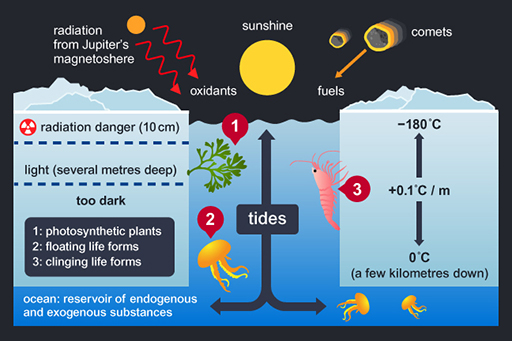2.7 Where might life be found on Europa?
If microbes do live on Europa, where might they occur?
The cracks on the surface are produced by tidal distortion. Such cracks may be the most likely place for life to occur on Europa, as they are at the surface, and so receive sunlight (unlike the water beneath the ice). They are also subject to currents as water is drawn upwards into opening cracks and then squeezed out of closing cracks. These currents can distribute nutrients and concentrate them at the surface in the cracks.
Life would need to avoid the top few centimetres because of intense radiation, but below that depth there would still be enough sunlight for photosynthesis.

The figure is a representation of a proposal by the American Richard Greenberg. Photosynthetic organisms occur near the surface in temporary cracks where they can receive sunlight. More complex organisms can float upwards when the tidal forces open the cracks. The squeezing and opening of these cracks in response to tidal forces moves organisms and nutrients up and down. This illustration shows large organisms, but there would surely be microscopic single-celled microbes too. Traces of life from this setting would be relatively easy to find, because some unlucky individuals would be squeezed out onto the surface along with the ridge-forming slush each time a crack closed.
